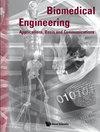通过评估非线性动力学相互作用对心肺角色交换的新发现
IF 0.6
Q4 ENGINEERING, BIOMEDICAL
Biomedical Engineering: Applications, Basis and Communications
Pub Date : 2022-06-28
DOI:10.4015/s1016237222500399
引用次数: 0
摘要
本文报道了将非线性动力学理论应用于心率(HR)和呼吸(RP)序列,探索心肺功能阴阳(被动-主动)相互作用现象的创新成果。根据中医的阴阳理论,人体内的器官系统以主动被动互换的方式相互作用。阳作为主动源支配着阴作为被动负荷。本文提出了基于递归分析的非线性互驱动因子[公式:见文]。NLID因子表征了两个非线性动力系统——心脏和呼吸系统之间的非线性相互作用。基于嵌入定理和相空间重构,对相轨迹构造的HR和RP循环图进行量化,计算NLID因子。持续注意任务中HR和RP递归图的异质模式反映了高度不可预测的系统动力学。令人惊讶的是,在静息状态下,异质性HR复发模式与几乎均匀的RP复发图相关,表明心肺相互作用相当弱。禅宗患者的HR复发虽有不规则的RP复发行为,但仍有明显的规律性。NLID因子揭示了禅修组由RP系统传递的阳能量在心脏系统中占主导地位。这些发现让我们注意到,在禅修状态下,心脏(和自主神经系统)可能具有非凡的自我调节能力。本文章由计算机程序翻译,如有差异,请以英文原文为准。
NOVEL FINDINGS ON CARDIORESPIRATORY ROLE SWAPPING BY ASSESSING NONLINEAR DYNAMICAL INTERACTIONS
This paper reports the innovative results of applying nonlinear dynamical theory to heart-rate (HR) and respiratory (RP) sequences to explore Yin–Yang (passive–active) interacting phenomenon of cardiorespiratory function. Organ systems inside human body interact mutually in the manner of swapping the active–passive role, according to Yin–Yang theory in traditional Chinese medicine. Yang as an active source rules over Yin as a passive load. Nonlinear inter-driven (NLID) factor, [Formula: see text], based on recurrence analysis is proposed in this study. NLID factor characterizes the nonlinear interactions between two nonlinear dynamical systems, cardiac and respiratory systems. NLID factor is computed by quantifying the HR and RP recurrent plots constructed from phase trajectories based on embedding theorem and phase-space reconstruction. Heterogeneous patterns of HR and RP recurrence plots in continuous-attention task reflect highly unpredictable system dynamics. Heterogeneous HR recurrence patterns are surprisingly associated with the nearly homogeneous RP recurrence plot at resting state, indicating rather weak cardiorespiratory interaction. HR recurrence in Zen exhibits notable regularity in spite of the irregular RP recurrence behaviors. NLID factor reveals prominent Yang energy delivered by RP system that dominates over the cardiac system in Zen-meditation group. Such findings draw our attention to the possibly extraordinary self-regularity power of heart (and autonomic nervous system) in the Zen-meditation state.
求助全文
通过发布文献求助,成功后即可免费获取论文全文。
去求助
来源期刊

Biomedical Engineering: Applications, Basis and Communications
Biochemistry, Genetics and Molecular Biology-Biophysics
CiteScore
1.50
自引率
11.10%
发文量
36
审稿时长
4 months
期刊介绍:
Biomedical Engineering: Applications, Basis and Communications is an international, interdisciplinary journal aiming at publishing up-to-date contributions on original clinical and basic research in the biomedical engineering. Research of biomedical engineering has grown tremendously in the past few decades. Meanwhile, several outstanding journals in the field have emerged, with different emphases and objectives. We hope this journal will serve as a new forum for both scientists and clinicians to share their ideas and the results of their studies.
Biomedical Engineering: Applications, Basis and Communications explores all facets of biomedical engineering, with emphasis on both the clinical and scientific aspects of the study. It covers the fields of bioelectronics, biomaterials, biomechanics, bioinformatics, nano-biological sciences and clinical engineering. The journal fulfils this aim by publishing regular research / clinical articles, short communications, technical notes and review papers. Papers from both basic research and clinical investigations will be considered.
 求助内容:
求助内容: 应助结果提醒方式:
应助结果提醒方式:


